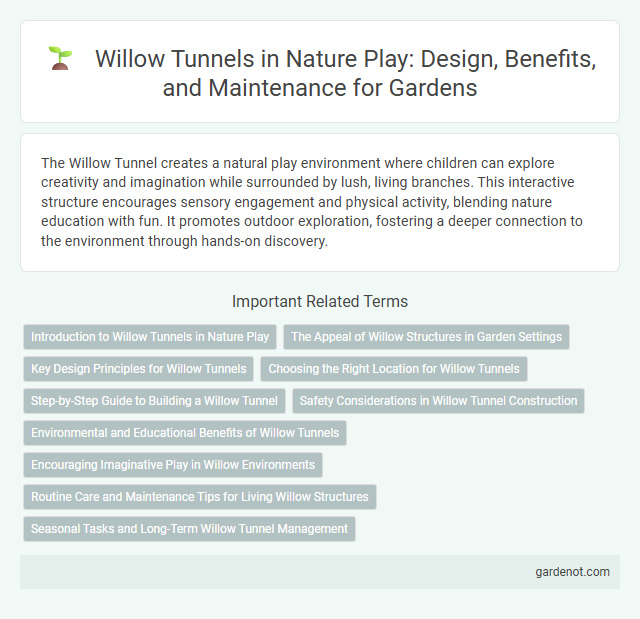The Willow Tunnel creates a natural play environment where children can explore creativity and imagination while surrounded by lush, living branches. This interactive structure encourages sensory engagement and physical activity, blending nature education with fun. It promotes outdoor exploration, fostering a deeper connection to the environment through hands-on discovery.
Introduction to Willow Tunnels in Nature Play
Willow tunnels are vibrant structures crafted from living willow branches, weaving a natural passage that encourages exploration and imaginative play in outdoor settings. These green, flexible arches provide children with a sensory-rich environment, fostering creativity, motor skills, and a connection to nature. Integrating willow tunnels in nature play areas enhances biodiversity while offering a dynamic, interactive space for learning and discovery.
The Appeal of Willow Structures in Garden Settings
Willow tunnels offer a captivating, natural aesthetic that seamlessly integrates with garden environments, providing a living, breathing structure that changes with the seasons. Their flexible, intertwined branches create inviting, shaded pathways that encourage exploration and imaginative play for children. These organic forms enhance biodiversity by supporting local wildlife and fostering a peaceful, immersive nature experience.
Key Design Principles for Willow Tunnels
Willow tunnel design emphasizes natural materials, prioritizing flexible willow rods that create an organic, immersive pathway for children to explore. Key principles include ensuring structural stability while maintaining a lightweight, breathable framework that encourages sensory engagement and imaginative play. The tunnel's form integrates seamlessly with the environment, fostering a connection to nature and supporting diverse physical activities.
Choosing the Right Location for Willow Tunnels
Selecting the ideal location for a willow tunnel requires assessing soil quality, sunlight exposure, and space availability to ensure healthy growth and structural stability. Areas with well-drained, nutrient-rich soil and access to full or partial sunlight promote vigorous willow shoots essential for weaving the tunnel walls. Proximity to water sources also facilitates irrigation, enabling consistent moisture levels vital for willow vitality and the long-term success of nature play installations.
Step-by-Step Guide to Building a Willow Tunnel
Start by selecting flexible willow branches approximately 6-8 feet long, ensuring they are fresh and pliable for easy weaving. Prepare the ground by marking two parallel rows about 3 feet apart and driving sturdy stakes every 2 feet to serve as anchor points. Gradually weave the willow branches horizontally through the stakes, bending and intertwining them tightly to create a sturdy, curved tunnel structure that encourages natural play and exploration.
Safety Considerations in Willow Tunnel Construction
Safety considerations in willow tunnel construction include selecting flexible but sturdy willow branches to prevent structural collapse and ensuring the tunnel's height and width accommodate easy movement without sharp edges. Proper anchoring of the willow frame into the ground enhances stability, while regular inspections for weak points or rot help maintain a secure play environment. Incorporating natural vegetation that doesn't pose allergy risks or toxic exposure is vital for children's health and safety during nature play.
Environmental and Educational Benefits of Willow Tunnels
Willow tunnels create immersive natural environments that foster children's connection to nature, promoting environmental stewardship from an early age. Their living structure supports biodiversity by providing habitats for insects and birds, enhancing local ecosystems. Educationally, willow tunnels encourage experiential learning, sensory exploration, and creativity, making them effective tools for outdoor classroom activities.
Encouraging Imaginative Play in Willow Environments
Willow tunnels create immersive natural spaces that stimulate imaginative play by offering children a tactile and visually dynamic environment. These green structures inspire storytelling, role-playing, and creative exploration, enhancing cognitive and social development. Integrating willow tunnels into outdoor play areas fosters a unique connection with nature, promoting creativity and environmental awareness.
Routine Care and Maintenance Tips for Living Willow Structures
Routine care of living willow structures like the Willow Tunnel involves regular watering to maintain healthy growth and prevent drying. Pruning is essential to remove dead or overgrown shoots, promoting dense, flexible branches that ensure structural integrity. Seasonal inspections help identify and address pest infestations or fungal issues, safeguarding the longevity of the natural tunnel.
Seasonal Tasks and Long-Term Willow Tunnel Management
Seasonal tasks for Willow tunnels include pruning to encourage healthy growth and removing any damaged or dead branches during early spring. Long-term management involves monitoring soil moisture levels, reinforcing structural support annually, and periodically weaving new shoots to maintain shape and stability. Consistent attention ensures the Willow tunnel remains a vibrant, safe, and sustainable natural play feature throughout the year.
Willow tunnel Infographic

 gardenot.com
gardenot.com